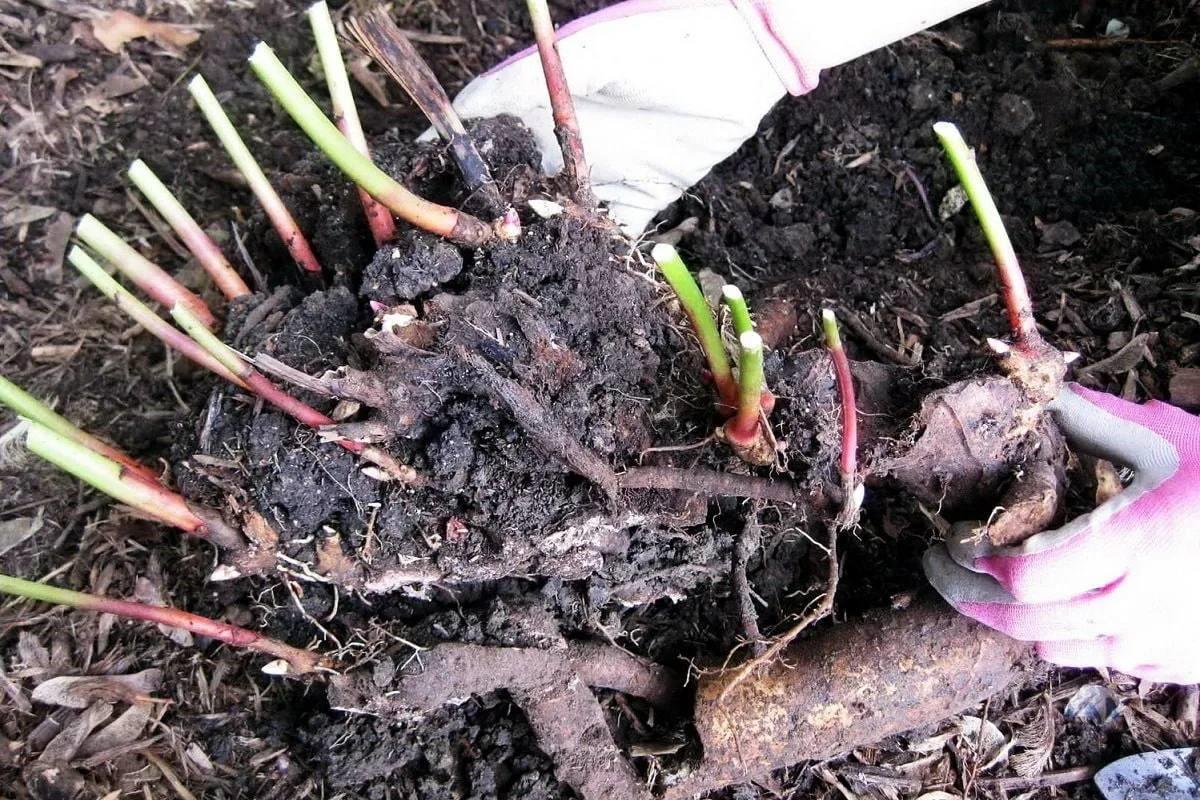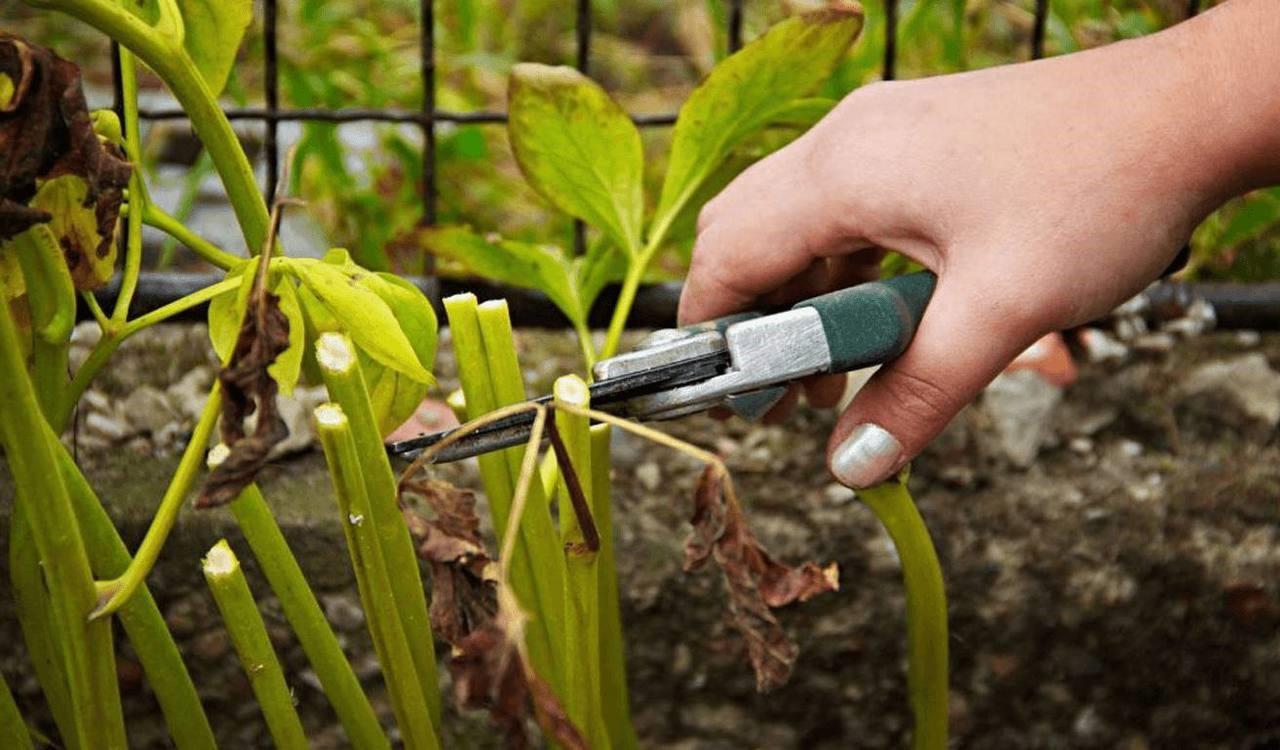Content
Like any other flower crop, peonies need periodic replanting. The procedure is carried out at a certain time, taking into account all the features. It is worth familiarizing yourself with how to replant peonies after flowering to another place.
Why is a transplant needed?

There is nothing complicated in transplanting peonies; the main thing is to take into account the timing and follow the rules of agricultural technology
In one area, flowers can live up to 100 years. Plants that have not been replanted for a long time produce ever smaller flowers, their number gradually decreasing. In order for peony bushes to enjoy lush flowering for a long time and not get sick, they need to be replanted every 5 years. Usually it is necessary to replant peonies more often if they do not feel well in their original place.
This is easy to determine, since a healthy bush blooms luxuriantly for a long time, the buds and flowers in size and color fully correspond to the varietal description. The foliage of this peony is rich green, shiny, and does not fall off. The bush itself is actively developing and growing.

Peonies look great in tandem with irises, roses, crocuses and lilies
There are other reasons for transplantation:
- Deterioration of soil quality. Flowers need a large amount of micro- and macroelements. As it develops, the bush consumes more and more of them. Fertilizer application is often not enough. Over time, the bushes grow greatly, the buds go deeper into the soil, and the root collar ages. Hollows appear in it, where various pests appear: ants, slugs. The land is also depleted, it becomes poor in nutrients. In addition to harmful insects, pathogenic microorganisms appear in the soil.
- heavily overgrown bushes. Due to the low demands of the crop, it does not tolerate shading or lack of air circulation. This is what happens when bushes grow excessively. Peonies shade their own shoots, and the allotted space becomes insufficient for them. The bush loses its decorative properties and is susceptible to disease.
- Redevelopment of the territory or relocation of the flower bed. Sometimes it turns out that peonies don’t look right in a certain part of the garden. Then transplanting them to a new place solves the aesthetic problem. In a new place, after transplantation, the peonies will bloom with redoubled force.
When to replant peonies
Many novice gardeners are interested in what is the best time to transplant peonies to another place in the summer. This is the end of August and the beginning of September. During this period it is still warm, there are no heavy rains, the bushes have time to take root over the winter and fully adapt to the new soil. The timing of transplantation may vary depending on the climate of a particular region.
Spring transplantation of peonies
Some gardeners prefer to replant the crop in the spring. This is advisable only when there is a threat of attack by rodents or pests.It is better that peonies are transplanted to a new location in August, always after flowering. It is still not worth performing the manipulation in the spring. Peonies may begin to hurt and form small buds. Sometimes bushes transplanted in spring do not bear flowers at all.
If you still need to transplant peonies in the spring, it is worth considering that vegetative roots begin to form at +5 degrees. The plant will have to spend a lot of effort to restore them. Peonies transplanted in spring take a long time to adapt and bloom only the next year. Therefore, it is better to transplant the peony to a new place in August.
Transplanting peonies to another place in summer
It is better to transplant peonies in the summer in August, from the second decade. This is the optimal month for performing transplant work. Over the summer, the bushes manage to stock up on nutrients and begin preparing for winter. Plants should be replanted when the air temperature reaches more than +20 degrees. If it is too hot outside, it is better to transplant on another day. In the heat, plants do not take root well, even if all the rules of agricultural technology are followed. Correctly transplanting a peony to a new place in the summer will give the bushes a second life.

It is better to transplant flowers while wearing rubber gloves.
Replanting peonies in autumn
After the flowering period ends, peonies slow down all life processes and gradually enter a resting phase. This is how they prepare for winter. It is recommended to start replanting the peony after flowering in late summer or early autumn. There should be at least 1.5 months left before the first cold weather. It is optimal to replant the plant in September. Then the culture will have enough time to adapt to the new place and prepare for winter.
Rainy, cool days are favorable for the active formation of rhizomes and the growth of new roots. By the end of November, the peony will be strong enough to lay the required number of flower buds for next year.
Autumn-summer transplantation of peonies should be carried out at different times, it all depends on the region:
- Kuban, Crimea and other southern regions - end of September (from the 20th).
- Moscow region, middle zone - it is better to replant plants no later than September 15.
- Siberia and the Ural region - it is considered optimal to transplant peonies to another place in August.
Residents of the south should take into account that, despite the mild climate, it is not advisable to transplant in October. Flowers may not take root.

After transplanting peony bushes in spring or summer, they will bloom only for 3-4 seasons
Choosing a new place
Peonies are a light-loving flower crop that does not tolerate drafts. Flowers require an area protected from the wind, well lit by the sun. Light partial shade is allowed after lunch so that the bushes can rest from the scorching rays of the sun.
Peonies should not be planted in the following places:
- too shaded areas where there is rarely sun;
- hills blown by winds from all sides;
- near tall trees, bushes and buildings;
- lowlands where rain or melt water accumulates.
Even if you replant peonies correctly in August, in such areas they will bloom irregularly and form small buds.
Soil preparation
Peonies prefer to grow in soil with an acidity level of 6.2-6.8 pH. If the soil is too acidic, first add wood ash and lime in the amount of 1 cup per 1 sq.m. Experienced gardeners recommend replanting peony crops in loamy, sandy loam soils.
You need to prepare the area in advance:
- The selected area is carefully loosened to get rid of weeds and improve soil aeration.
- Dig holes 60 cm deep and 80*80 cm in diameter.
- A drainage layer of expanded clay, broken brick, gravel or crushed stone is placed at the bottom of the holes.
- Add a nutrient mixture of bone meal (400 g), superphosphate (80 g), ferrous sulfate (10 g) and potassium chloride (50 g).
- The excavated soil is mixed with coarse sand, peat and compost in equal proportions, and poured into the recesses to half the depth.
- The holes are watered generously with settled water - 3 liters are needed for 1 bush.
It is recommended to begin preparatory work two weeks before the planned transplant date.

You can use ready-made fertilizer for peonies and roses
How to replant peonies correctly
In order for plants to take root safely in a new place, they must be replanted correctly. To do this, you need to complete the following steps:
- prepare the holes;
- add fertilizer to the holes;
- carefully dig up the bush with its root system;
- correctly divide the rhizome;
- prepare the divisions for transplantation;
- Place the bushes in the holes and water them with water.
It is better to keep all the tools necessary for transplantation at hand.
Digging and dividing rhizomes
The root system must be handled as carefully as possible due to its fragility. Before transplanting, it is carefully dug out along with a lump of earth.
Algorithm of actions:
- The bush intended for transplantation is dug at a distance of 35-40 cm from the stems.
- Place the pitchfork in the dug groove and carefully loosen the peony. Afterwards, they take it out of the ground along with the root system.
- The roots are carefully freed from adhering soil with your hands. You cannot roughly shake or knock the rhizome on the ground.
- The peony is left for 4-5 hours so that the root system dries out.Afterwards, using a garden knife, cut off damaged, dried root shoots and shoots at a level of 20 cm. The tool must be disinfected in advance in potassium permanganate or alcohol.
- If necessary, divide the rhizome into parts. Each division must have at least 4 buds.
- The root system of prepared peony cuttings is dipped into a fungicide solution. Sprinkle the cut areas with ash or crushed activated carbon.
It is also worth inspecting the root system for damage by insects and pathogenic microorganisms.

Before transplanting, you can soak peony divisions for 2 hours in growth stimulator Epin, Zircon
Planting a flower in a new place
After performing the necessary manipulations with the rhizome, the peony is transplanted to a new place.
Follow these instructions:
- In the middle of the planting hole, dig another hole and fill it with water.
- The delenka is placed in a hole, covered with earth so that the root collar is covered by 5-7 cm. If the buds remain on top, they will dry out and die.
- The transplanted bush is watered abundantly with settled water.
To prevent invasions of beetles and pathogenic microorganisms, it is better to add potassium permanganate (pale pink solution) to the water for irrigation.
Care after transplant
After transplantation, peonies require standard care. A set of measures implies adherence to the schedule:
- Flowers need to be irrigated once a week, when the soil dries out. Do not pour too much liquid too often, as excess moisture promotes the development of fungal diseases.
- The soil under the bush should be loosened periodically to improve aeration of the rhizome and remove weeds.
- Fertilizers are applied three years after transplantation. Nutrient compositions are added 4 times during the growing season.Each peony bush contains 35 g of any mineral complex with a high nitrogen content. The second feeding is carried out during the budding phase, using the same amount of fertilizer. The last feeding should also be phosphorus-potassium.
- As they fade, the flower stalks are removed with a disinfected sector or garden shears.
You can periodically treat specimens after transplantation with special preparations to prevent the development of diseases and attacks of harmful beetles.

Trimming withered buds must be done with disinfected pruning shears, otherwise there is a risk of infection.
Conclusion
If you take into account the recommendations of experienced gardeners and the rules of agricultural technology, replanting peonies after flowering will not be difficult. The main thing is to choose the right date, weather, and prepare the necessary equipment.








